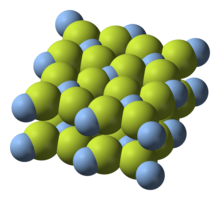Silver(II) fluoride

| |

| |
| Names | |
|---|---|
| IUPAC name
silver(II) fluoride
| |
| Other names
silver difluoride
| |
| Identifiers | |
3D model (
JSmol ) |
|
| ChemSpider | |
ECHA InfoCard
|
100.029.124 |
| EC Number |
|
PubChem CID
|
|
| UNII | |
CompTox Dashboard (EPA)
|
|
| |
| |
| Properties | |
| AgF2 | |
| Molar mass | 145.865 g/mol |
| Appearance | white or grey crystalline powder, hygroscopic
|
| Density | 4.58 g/cm3 |
| Melting point | 690 °C (1,274 °F; 963 K) |
| Boiling point | 700 °C (1,292 °F; 973 K) (decomposes) |
| Decomposes | |
| Structure | |
| orthorhombic | |
| tetragonally elongated octahedral coordination | |
| linear | |
| Hazards | |
| Occupational safety and health (OHS/OSH): | |
Main hazards
|
toxic, reacts violently with water, powerful oxidizer |
| GHS labelling: | |
   
| |
| Danger | |
| H272, H301, H302, H311, H312, H314, H331, H332 | |
| P210, P220, P221, P260, P261, P264, P270, P271, P280, P301+P310, P301+P312, P301+P330+P331, P302+P352, P303+P361+P353, P304+P312, P304+P340, P305+P351+P338, P310, P311, P312, P321, P322, P330, P361, P363, P370+P378, P403+P233, P405, P501 | |
| NFPA 704 (fire diamond) | |
| Safety data sheet (SDS) | MSDS |
| Related compounds | |
Other anions
|
Silver(I,III) oxide |
Other cations
|
Cadmium(II) fluoride
Mercury(II) fluoride |
Related compounds
|
Silver subfluoride Silver(I) fluoride |
Except where otherwise noted, data are given for materials in their standard state (at 25 °C [77 °F], 100 kPa).
| |
Silver(II) fluoride is a chemical compound with the formula AgF2. It is a rare example of a silver(II) compound - silver usually exists in its +1 oxidation state. It is used as a fluorinating agent.
Preparation
AgF2 can be synthesized by fluorinating Ag2O with elemental
As a strong fluorinating agent, AgF2 should be stored in
AgF2 can be purchased from various suppliers, the demand being less than 100 kg/year. While laboratory experiments find use for AgF2, it is too expensive for large scale industry use. In 1993, AgF2 cost between 1000-1400
Composition and structure
AgF2 is a white crystalline powder, but it is usually black/brown due to impurities. The F/Ag ratio for most samples is < 2, typically approaching 1.75 due to contamination with Ag and oxides and carbon.[3]
For some time, it was doubted that silver was actually in the +2 oxidation state, rather than some combination of states such as AgI[AgIIIF4], which would be similar to silver(I,III) oxide. Neutron diffraction studies, however, confirmed its description as silver(II). The AgI[AgIIIF4] was found to be present at high temperatures, but it was unstable with respect to AgF2.[4]
In the gas phase, AgF2 is believed to have D∞h symmetry.
Approximately 14
Uses
AgF2 is a strong
3, the blue-violet AgF2−
4, and AgF4−
6.[5]
It is used in the fluorination and preparation of organic perfluorocompounds.[6] This type of reaction can occur in three different ways (here Z refers to any element or group attached to carbon, X is a halogen):
- CZ3H + 2 AgF2 → CZ3F + HF + 2 AgF
- CZ3X + 2AgF2 → CZ3F + X2 + 2 AgF
- Z2C=CZ2 + 2 AgF2 → Z2CFCFZ2 + 2 AgF
Similar transformations can also be effected using other high valence metallic fluorides such as CoF3, MnF3, CeF4, and PbF4.
AgF
2 is also used in the fluorination of
- C6H6 + 2 AgF2 → C6H5F + 2 AgF + HF
AgF
2 oxidises xenon to xenon difluoride in anhydrous HF solutions.[8]
- 2 AgF2 + Xe → 2 AgF + XeF2
It also oxidises carbon monoxide to carbonyl fluoride.
- 2 AgF2 + CO → 2 AgF + COF2
It reacts with water to form oxygen gas:[citation needed]
- 4 AgF2 + 4 H2O → 2 Ag2O + 8 HF + O2
AgF
2 can be used to selectively fluorinate pyridine at the ortho position under mild conditions.[9]
Safety
AgF
2 is a very strong oxidizer that reacts violently with water,
2, and elemental silver.[11]
References
- )
- ^ Encyclopedia of Chemical Technology. Kirk-Othermer. Vol.11, 4th Ed. (1991)
- .
- PMID 15926841.
- ISBN 0-12-352651-5.
- .
- .
- .
- S2CID 6584890.
- ^ ISBN 0-8493-8671-3.
- ^ ISBN 978-1-85617-567-8.
- ^ ISBN 978-0-470-38763-4.

